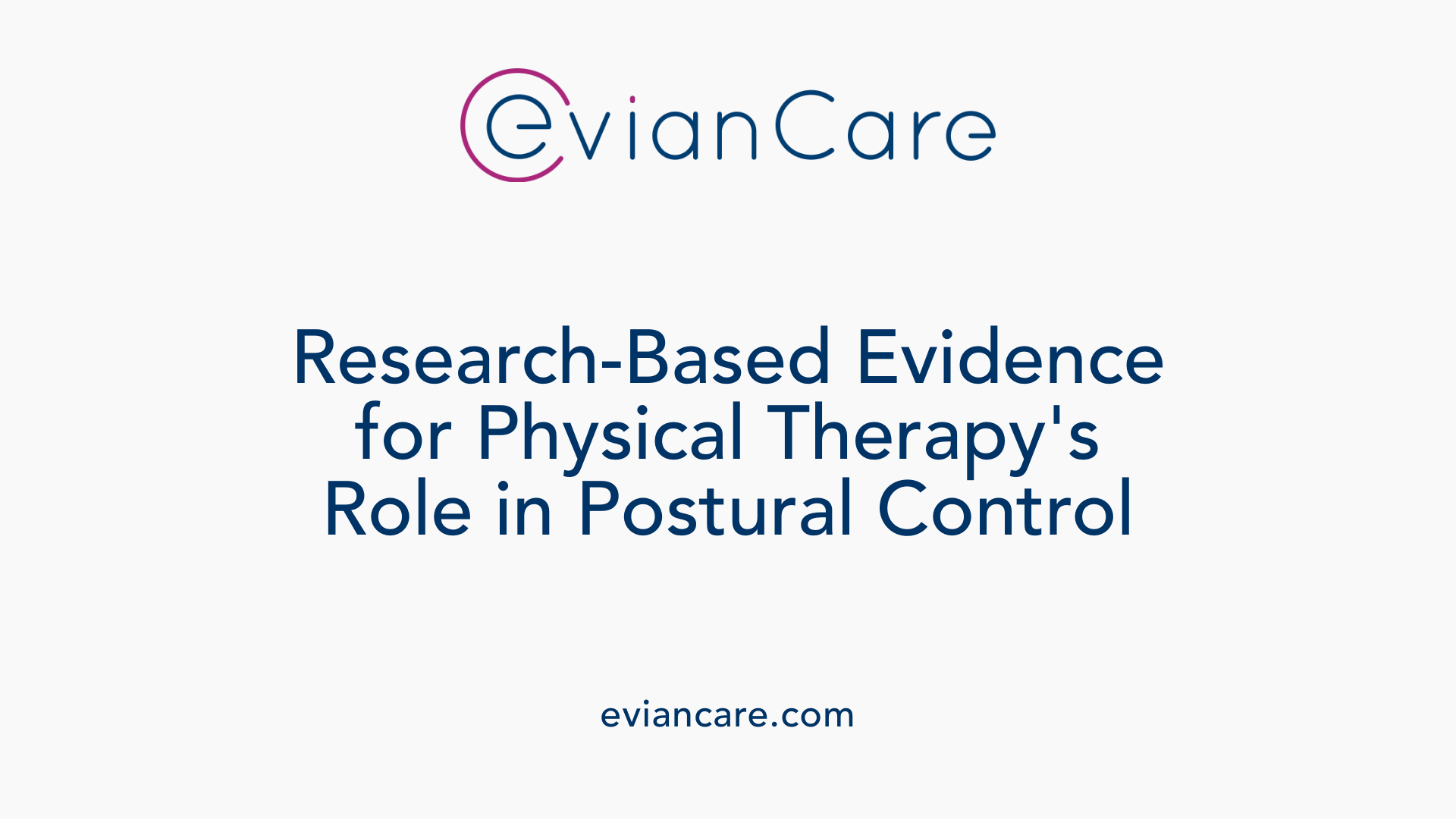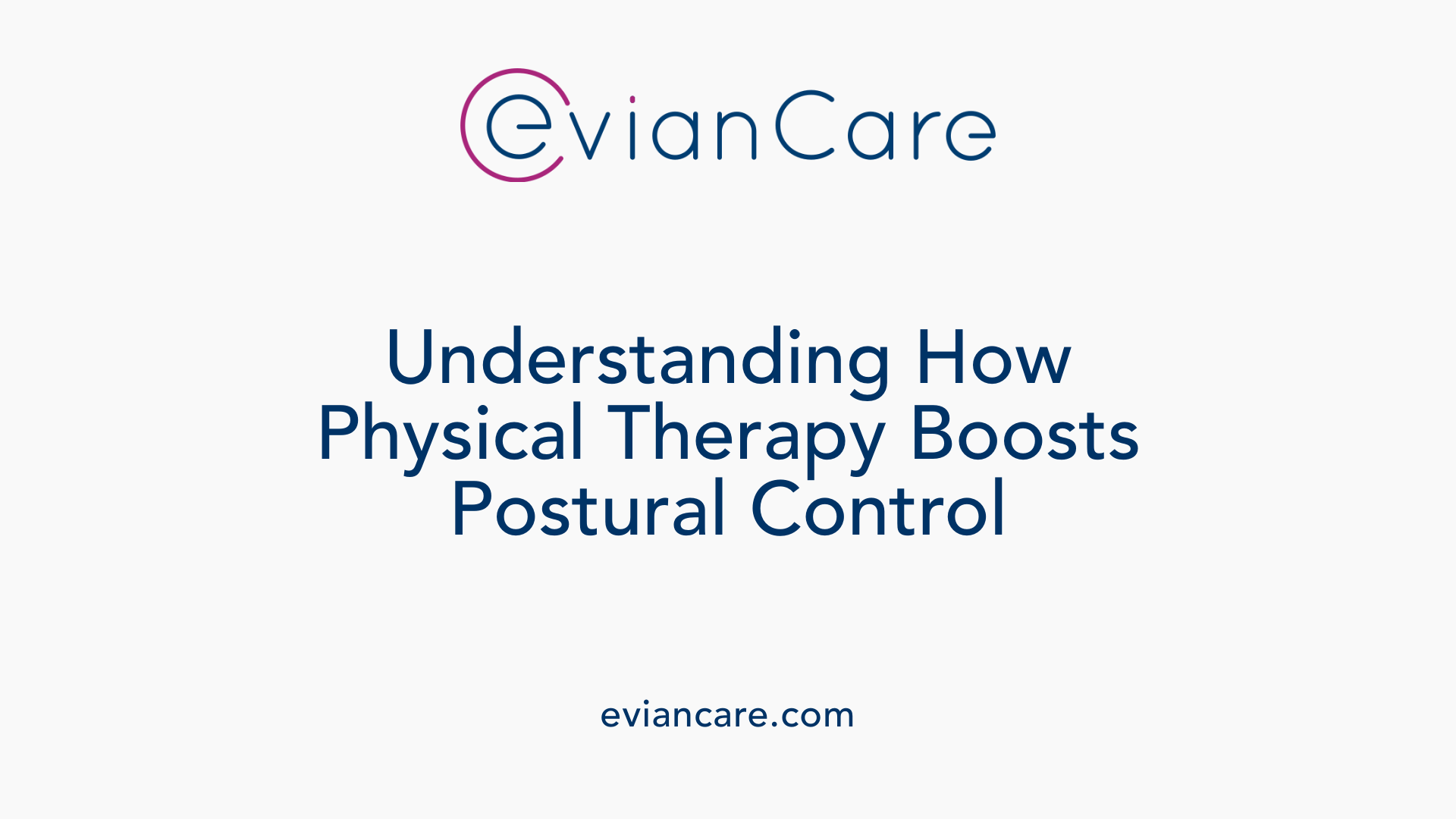
Understanding the Foundations of Postural Control and the Role of Physical Therapy
Postural control is fundamental for safe and effective movement, involving complex interactions between sensory inputs, motor responses, and environmental factors. It ensures balance, stability, and coordination across a variety of activities. Physical therapy plays a critical role in assessing and improving this multifaceted system, employing tailored exercises and interventions aimed at optimizing postural stability. This article explores the different types of postural control, the exercises that promote stability, the populations that benefit, and the scientific evidence supporting these strategies.
Types of Postural Control and Their Significance

What are the different types of postural control?
Postural control is essential for maintaining balance and stability during various activities. It encompasses several mechanisms that work together seamlessly to keep the body upright and centered.
There are four main categories of postural control:
Static Postural Control: This involves maintaining the body's position when standing still or holding a posture. Even during quiet standing, the body makes subtle adjustments to keep the center of mass (COM) within the base of support (BOS). Proper static control ensures stability when there's no movement or external disturbance.
Reactive Postural Control: This mechanism activates in response to unexpected disruptions, such as a sudden push or loss of balance. It allows the body to recover from these perturbations by employing strategies like ankle and hip adjustments or taking a step to prevent falling.
Anticipatory (Proactive) Postural Control: Before initiating voluntary movements, the central nervous system pre-activates specific muscles to adjust posture and maintain equilibrium. This feedforward process helps prevent destabilization during activities like reaching for an object or standing on one leg.
Adaptive Postural Control: Adaptation involves modifying postural responses based on changes in the environment or sensory inputs. For example, standing on an unstable surface or in low-light conditions requires sensory re-weighting—shifting reliance among visual, vestibular, and somatosensory cues to preserve balance.
All four mechanisms are interconnected and crucial for effective balance. They enable individuals to perform daily tasks safely, respond to sudden changes, and adjust to new or challenging environments. Impairments in any of these systems can lead to dizziness, falls, or instability, especially in populations such as older adults or those with neurological conditions.
Understanding these types aids clinicians in developing targeted interventions. For instance, balance training that challenges reactive control prepares individuals for unexpected perturbations, while exercises focusing on anticipatory control improve readiness for voluntary movements.
In summary, static, reactive, anticipatory, and adaptive postural controls represent a comprehensive framework for understanding how humans maintain stability across different circumstances. Enhancing these mechanisms through tailored training can significantly improve balance and reduce fall risk.
Exercises to Enhance Postural Stability

What exercises can improve postural control?
Improving postural control involves engaging in specific exercises that strengthen muscles, enhance flexibility, and challenge balance systems. A well-rounded routine includes yoga, stretching, muscle strengthening, and balance-specific activities tailored to target key muscle groups involved in maintaining good posture.
Yoga poses such as Child’s Pose, Cat-Cow, downward-facing dog, and Pigeon Pose are excellent for improving spinal alignment, increasing flexibility, and promoting body awareness. These movements help stretch tight muscles and improve posture over time.
Stretching routines focusing on the chest, back, and hips can correct muscular imbalances that contribute to poor posture. For example, chest doorway stretches open up tight anterior muscles, while hip flexor stretches reduce anterior pelvic tilt.
Strengthening exercises targeting the upper back, shoulders, and core are crucial. Band pull-aparts, scapular wall slides, and prone I, T, and Y exercises help strengthen the scapular stabilizers and back muscles, addressing rounded shoulders and slouching.
Lower body strengthening, including lunges, squats, and leg lifts, supports overall balance and postural stability.
Incorporating balance activities like standing on one leg, balance board exercises, or dynamic movements such as heel-to-toe walking builds proprioception and coordination.
Consistency is key. Performing these exercises regularly, integrated into a 30-day routine, enhances muscle memory and sustains improvements in posture and stability.
While self-directed exercise is beneficial, consulting with healthcare professionals like physical therapists ensures personalized guidance. They can tailor routines based on individual needs, underlying issues, and specific goals, maximizing the benefits of the exercises.
In summary, a combination of stretching, strengthening, and balance exercises forms a comprehensive approach to improving postural control, helping to prevent discomfort, improve movement efficiency, and support overall musculoskeletal health.
Physical Therapy's Contribution to Balance and Postural Control
What is the role of physical therapy in improving postural control and balance?
Physical therapy is instrumental in enhancing postural stability and balance by addressing multiple contributing factors. It primarily focuses on strengthening muscles that are essential for maintaining proper posture, especially in the legs and core. Through targeted exercises, physical therapists help improve the strength, flexibility, and endurance of these muscle groups, which are vital for supporting the body's alignment and movement.
Beyond muscle strengthening, sensory training is a crucial component of therapy. Exercises are designed to challenge and refine the sensory systems involved in balance, including visual, vestibular, and somatosensory inputs. These may involve activities like balance board exercises, standing on unstable surfaces, or eye-tracking tasks, which stimulate sensory receptors and improve the body's ability to process and respond to sensory information.
Education also plays a vital role. Patients are taught about safe movement patterns, environmental modifications, and the importance of supportive footwear, all of which facilitate better balance and reduce fall risk in daily life. Therapists often advise on home exercises and lifestyle adaptations to reinforce gains made during therapy sessions.
Personalized interventions form the cornerstone of effective balance rehabilitation. Therapists design tailored, gradually challenging routines that consider the individual’s specific deficits, age, and activity level. These exercises might include proprioception drills, gait training, and reaction time improvements, which collectively enhance coordination and stability.
Improvements in trunk control and overall postural stability are especially significant for populations vulnerable to balance impairments, such as older adults, individuals with low back pain, or those recovering from neurological conditions. Regular physical therapy not only restores balance but also boosts confidence, mobility, and independence.
In summary, physical therapy combines muscle strengthening, sensory input enhancement, education, and individualized program design to drastically improve postural control and balance. These efforts reduce fall risks, alleviate pain, and support a safer, more active lifestyle across diverse groups.
Populations Benefiting from Physical Therapy for Postural Control
 Various groups across different age ranges and health conditions can significantly benefit from physical therapy aimed at improving postural control. Children, particularly those between the ages of 6 and 12, are a primary population where targeted exercises help foster neuromuscular development, balance, and coordination. These improve not only motor function but also support broader cognitive and psychosocial growth.
Various groups across different age ranges and health conditions can significantly benefit from physical therapy aimed at improving postural control. Children, particularly those between the ages of 6 and 12, are a primary population where targeted exercises help foster neuromuscular development, balance, and coordination. These improve not only motor function but also support broader cognitive and psychosocial growth.
Older adults are another key group. As aging affects sensory systems, muscle strength, and coordination, balance exercises can reduce fall risks and promote independence. Physical therapy strategies for seniors often include sensory integration, strength training, and environmental modifications.
Individuals with neurological conditions such as cerebral palsy, stroke, Parkinson’s disease, and autism spectrum disorder face special challenges with postural stability. For example, children with cerebral palsy may exhibit impaired balance and coordination, which tailored exercises and therapies can enhance. Vestibular and sensory integration therapies have shown to improve their stability, helping them perform daily activities more safely.
People with musculoskeletal issues like low back pain or postural imbalances also benefit from physical interventions. Strengthening core and back muscles, correcting alignment, and retraining postural reflexes help alleviate discomfort and prevent further injury. Similarly, recovery after surgeries involving the spine or joints often includes balance and posture training to restore function.
Additionally, individuals with neurodevelopmental or acquired impairments, such as Down syndrome or brain injuries, exhibit postural deficits that can be mitigated through specific physical therapy programs. These include core stabilization exercises, reactive and anticipatory balance work, and sensory integration techniques.
In summary, children, older adults, and those with neurological or musculoskeletal conditions represent primary populations who benefit from focused physical therapy. Customizing interventions based on age, condition, and functional needs ensures improvements in stability, mobility, and overall quality of life.
Scientific Evidence Supporting Physical Therapy for Postural Control

What is the evidence supporting physical therapy methods for enhancing postural control?
A body of scientific research indicates that physical therapy interventions can effectively improve postural control across various populations. Systematic reviews and multiple clinical studies provide insights into which strategies are most beneficial, although findings are sometimes mixed due to variations in methodology and patient characteristics.
Research focused on children with cerebral palsy has demonstrated positive effects of different physical therapy approaches. For example, aquatic physical therapy showed short-term improvements in postural stability, with gains measured by tools such as the Gross Motor Function Measure-66 (GMFM-66). Similarly, innovative therapies like electrical stimulation—transcranial direct-current stimulation (tDCS) and stochastic resonance stimulation—have yielded positive outcomes for static and dynamic balance. These enhancements, however, tend to diminish after therapy sessions end unless combined with other interventions.
In adults and elderly populations, targeted exercise programs like balance training, dance, and Tai Chi have proven effective. A meta-analysis of 22 trials involving over 1,000 participants with Parkinson’s disease found significant improvements in postural stability, especially when exercises explicitly challenge balance components.
However, the quality of evidence varies. The Cochrane systematic review on post-stroke rehabilitation, for instance, highlighted that much of the existing research is limited by small sample sizes and methodological heterogeneity. It concluded that while various physiotherapy techniques, including gait training, vestibular rehabilitation, and core strengthening exercises, show promise, definitive evidence for the superiority of any one approach remains lacking.
Specifically, interventions targeting reactive trunk control—such as exercises on Swiss balls and dynamic movement drills—can significantly enhance the automatic muscle responses necessary for recovering balance after perturbations. These are particularly useful in managing low back pain patients, as improved trunk response can reduce the chances of recurrent injuries.
In summary, although numerous studies support the use of physical therapy to improve balance and postural control, the evidence underscores the importance of individualized, multimodal programs. High-quality, large-scale randomized controlled trials are needed to definitively identify the most effective strategies for different patient groups.
| Intervention Type | Population | Outcome Measures | Notable Findings |
|---|---|---|---|
| Aquatic Therapy | Children with CP | GMFM-66, K-TCMS | Short-term improvements in postural control |
| Electrical Stimulation | Children with CP | Balance assessments | Significant static and dynamic balance gains |
| Virtual Reality | Various | CoP sway, balance tests | Significant improvements, especially with combined therapy |
| Balance & Gait Training | Elderly, PD | Multiple balance scales | Enhanced stability and reduced fall risk |
| Trunk Control Exercise | Low back pain | Motor scales, response time | Improved trunk muscle response and reduced episodes |
This evidence highlights the potential of physical therapy approaches but also emphasizes the need for further rigorous research to optimize techniques and outcomes in postural control rehabilitation.
Mechanisms Through Which Physical Therapy Enhances Postural Control

How does physical therapy work to improve postural control?
Physical therapy plays a vital role in enhancing postural stability by targeting multiple underlying mechanisms that contribute to balance. One of the primary approaches involves strengthening and conditioning muscles that support proper alignment. Therapists design exercises such as planks, bridges, and various stretches to bolster core, back, neck, and spinal muscles. These activities improve muscle endurance and control, which are essential for maintaining posture during both static and dynamic activities.
Beyond muscle strength, physical therapy emphasizes sensorimotor integration. This involves training the nervous system to better process and respond to sensory information from the visual, vestibular, and somatosensory systems. By doing so, individuals learn to better interpret environmental cues and adjust their movements accordingly. Techniques such as balance board exercises, proprioception drills, and vestibular rehabilitation help improve the body's ability to detect and correct deviations from an optimal posture.
Neuromuscular control is another critical component. Therapists utilize manual therapy, postural retraining, and ergonomic advice to correct muscular imbalances and promote proper body alignment. These interventions help improve coordination between muscles and refine movement patterns, which are crucial for dynamic stability. Engaging in functional and reactive exercises, including water-based activities and dynamic movement challenges, further enhances the body's ability to respond to unexpected disturbances, strengthening reactive and anticipatory balance strategies.
Overall, physical therapy employs a comprehensive, evidence-based approach that integrates strength training, sensory integration, neuromuscular control, and functional movement exercises. This multifaceted strategy promotes greater stability, reduces pain, minimizes fall risk, and supports optimal postural control, significantly improving overall mobility and quality of life.
Insurance Coverage and Assessment Tools for Postural Control Issues
Is postural correction often covered by insurance?
Insurance policies vary widely when it comes to postural correction therapies. While many plans offer coverage for physical therapy aimed at treating musculoskeletal issues, they do not always extend to non-medical or wellness approaches like Egoscue or muscle retraining exercises unless these are specifically deemed medically necessary. Typically, insurance providers are more willing to reimburse therapies that address injuries, postural misalignments, or functional impairments recognized as medically relevant. Patients should directly consult their insurance providers to understand the scope of coverage for postural correction interventions. It's often necessary to provide documentation of dysfunction or injury and possibly obtain prior authorization to qualify for reimbursement. Overall, coverage is unpredictable and can depend on the individual policy, the clinical justification, and the documentation provided.
What assessments are used to diagnose postural control issues?
Diagnosing issues with postural control involves a combination of clinical evaluations and instrumental measurements. Common clinical tests include the Berg Balance Scale, which assesses static and dynamic balance through a series of functional tasks. The Postural Assessment Scale for Stroke (PASS) is used especially in neurological cases to evaluate static and moving postures.
For a more detailed analysis, perturbation-based tests challenge individuals with unexpected external disturbances to observe their reactive balance responses. Posturographic analysis, using force plates or stabilometers, measures sway parameters and the displacement of the center of pressure (CoP), providing precise data on balance stability.
Electromyography (EMG) recordings help analyze muscle activation patterns during postural tasks, identifying delays or deficiencies in muscular responses. Functional assessments like single-leg semi-squats or gait analysis also contribute valuable insights into an individual’s dynamic postural control.
Combining these different tools allows clinicians to thoroughly understand the underlying deficits in postural stability and develop targeted intervention strategies.
More information search query
"Postural control assessments and insurance coverage" can help locate current guidelines, detailed assessment techniques, and policy-specific coverage details, aiding both clinicians and patients in navigating available options for diagnosing and managing postural control issues.
Summary and Future Directions in Postural Control Management
Effective management of postural control issues through physical therapy requires a comprehensive understanding of the underlying mechanisms, tailored exercises, and ongoing assessment. As research advances, integrating emerging approaches such as virtual reality, electrical stimulation, and biofeedback can enhance treatment outcomes. Emphasizing early intervention, personalized care, and evidence-based protocols will continue to improve functional stability and quality of life for diverse populations. Continued research is essential to refine therapy strategies, establish long-term benefits, and optimize rehabilitation programs for postural control.
References
- Postural Control - Physiopedia
- Using Physical Therapy to Improve Your Postural Trunk Control
- An Overview of the Available Intervention Strategies for Postural ...
- 6 Best Physical Therapy Posture Exercises To Reduce Pain
- Improving Postural Control Through Physical and Occupational ...
- Efficacy and effectiveness of physical therapy in enhancing postural ...
- Exercises To Improve Your Balance: Postural Control - [P]rehab
- Balance Physical Therapy Exercises for Improved Function












